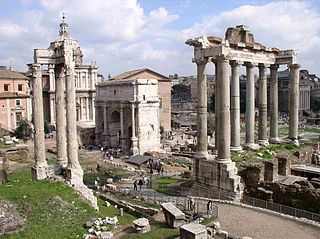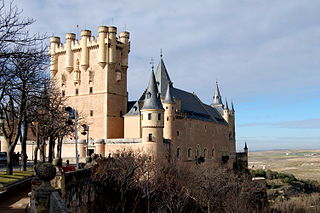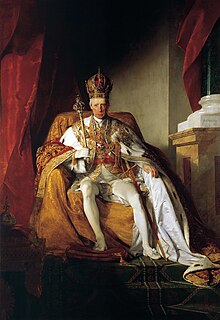Emmendingen is a Landkreis (district) in the west of Baden-Württemberg, Germany. Neighbouring districts are Ortenaukreis, Schwarzwald-Baar, Breisgau-Hochschwarzwald and the district-free city Freiburg. To the west it borders the French département Bas-Rhin.
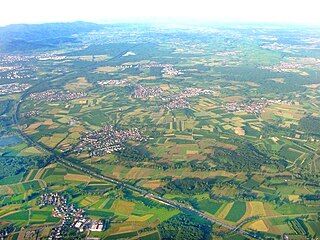
Breisgau is an area in southwest Germany between the Rhine River and the foothills of the Black Forest. Part of the state of Baden-Württemberg, it centers on the city of Freiburg im Breisgau. The district Breisgau-Hochschwarzwald, which partly consists of the Breisgau, is named after the Black Forest area. Parts of the Breisgau are also situated in the political districts of Freiburg im Breisgau and Emmendingen.

Emmendingen is a town in Baden-Württemberg, capital of the district Emmendingen of Germany. It is located at the Elz River, 14 km (8.7 mi) north of Freiburg im Breisgau. The town contains more than 26,000 residents, which is the most in the Emmendingen district.

Hluboká nad Vltavou, until 1912: Podhrad, German: Frauenberg) is a town in the South Bohemian Region of the Czech Republic.

The Hochburg is a castle ruin situated between the city of Emmendingen and the village of Sexau in the region of Baden, located in the southwest of Germany. It was presumably built in the 11th century and was originally known as castle Hachberg. The line of nobles known as the Margraves of Baden-Hachberg most likely derive their name from this castle and before it was razed by the French it was the second largest fortification in Baden.

Vimperk is a town in the South Bohemian Region of the Czech Republic. In 2000 the town had 8,090 inhabitants. Vimperk is situated in the Šumava region in the Volyňka River valley among the foothills of the Boubín Mountains. The town elevation is 700 metres above sea level.

The Münstertal is a municipality in the southern Black Forest, which belongs to the district of Breisgau-Hochschwarzwald in Baden-Württemberg in southern Germany. It is 3 miles east from Staufen.

Buchenbach is a municipality in the south west of the Black Forest in Germany. It is located in the district of Breisgau-Hochschwarzwald in Baden-Württemberg. It is made up of four communities, the main town of Buchenbach and the villages of Falkensteig, Unteribental and Wagensteig. The current municipality was formed by the merger of the former entities of Buchenbach and Falkensteig on 1 December 1971, with Wagensteig being joined to them on 1 August 1973 and Unteribental on 1 January 1975.
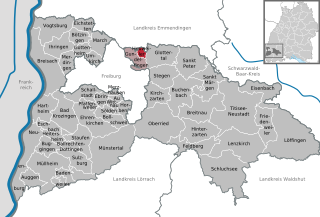
Heuweiler is a village in the district of Breisgau-Hochschwarzwald in the southwest of Baden-Württemberg near Freiburg in southern Germany.

Wiesbach is a municipality in Südwestpfalz district, in Rhineland-Palatinate, in the southwest of Germany. The place name is composed of the two German words for meadow and brook.

Güssenburg Castle is a ruined castle on a hill near Hermaringen in Heidenheim County in Baden-Württemberg, Germany. It was built around 1346, during the High Middle Ages and much of the curtain wall and keep remain.

The Elz Valley Railway is a 19.3 km (12.0 mi) long, single-tracked, standard gauge branch line in the Black Forest area of the German state of Baden-Württemberg. The line branches off the Freiburg im Breisgau to Offenburg section of the Rhine Valley Railway at Denzlingen and runs up the valley of the River Elz to Waldkirch and Elzach.

Orlík Castle is a château 500 metres (1,600 ft) northeast of the village of Orlík nad Vltavou, in the northern part of the District of Písek, in the South Bohemia Region of the Czech Republic. The original position of the chateâu, on a rock 60 metres (200 ft) above the Vltava valley, was altered by the creation of the Orlík reservoir in 1954–62, and the chateâu is now barely a few metres above the water level.

The Küssaburg, Küssenberg or Küssaberg Castle is a ruined hilltop castle located at an elevation of 634 m above sea level (NN) in Bechtersbohl, a village in the municipality of Küssaberg, in the county of Waldshut in the German state of Baden-Württemberg.

Falkenstein Castle is a ruined hill castle near Freiburg im Breisgau on the territory of the present-day municipality Breitnau in the county of Breisgau-Hochschwarzwald in the German state of Baden-Württemberg. The castle site lies in a triangle formed by the entrance of the Höllental valley – the Lower Höllental and the Engenbach valley, not far from the Buchenbach village of Falkensteig, 617.6 m above sea level (NN) on a rocky crag that is very difficult to get to today. Of the castle itself only a few wall remains are left. It is one of the less well preserved ruins in the Breisgau.

Bubenstein Castle, also called New Falkenstein Castle (Neu-Falkenstein), is a ruined spur castle at 560 m above sea level (NN) on a rock spur on the northern side of the Höllental valley, about 500 metres west of Old Falkenstein Castle above the village of Falkensteig in the municipality of Buchenbach in the county of Breisgau-Hochschwarzwald in the southwest German state of Baden-Württemberg.

Wiesneck Castle is a ruined castle in the village of Wiesneck in the municipality of Buchenbach in the Southern Black Forest in the county of Breisgau-Hochschwarzwald in the southwest German state of Baden-Württemberg.
•Alfons Zettler, Thomas Zotz: Die Burgen im mittelalterlichen Breisgau, I. Nördlicher Teil: Halbband L-Z. Jan Thorbecke Verlag, Ostfildern 2006, ISBN 3-7995-7365-8, pp. 470–496.
